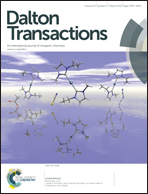Mixed amidophenolate–catecholates of molybdenum(vi)†
Abstract
The dioxomolybdenum(VI) complex (tBuClipH2)MoO2 (tBuClipH4 = 4,4′-di-tert-butyl-N,N′-bis(3,5-di-tert-butyl-2-hydroxyphenyl)-2,2′-diaminobiphenyl) reacts with 3,5-di-tert-butylcatechol to form oxo-free (tBuClip)Mo(3,5-tBu2Cat). The bis(amidophenoxide)-monocatecholate complex is monomeric and exhibits a cis-β geometry in the solid state. Variable-temperature NMR data are consistent with two fluxional processes, one that interconverts several geometric isomers at low temperature, and a second that interchanges the ends of the tBuClip ligand at ambient temperatures. The high-temperature fluxional process can be explained by a single Bailar trigonal twist coupled with atropisomerization of the chiral diaminobiaryl backbone. Addition of excess catechol to (tBuClipH2)MoO2 results in formation of a dimolybdenum mono-oxo complex (tBuClip)Mo(μ-3,5-tBu2Cat)2Mo(O)(3,5-tBu2Cat). This complex, which contains a seven-coordinate bis(amidophenoxide)molybdenum center and a six-coordinate oxomolybdenum center, represents a structural hybrid between dimeric oxomolybdenumbis(catecholate) and molybdenum tris(catecholate) complexes. Both mono- and dimolybdenum complexes are best formulated as containing Mo(VI), but there is structural evidence for significant π donation from the amidophenolates. (tBuClip)Mo(3,5-tBu2Cat) binds pyridine to form a mixture of isomeric seven-coordinate adducts. The Lewis acidity of the mixed amidophenoxide-catecholate appears to be lower than its tris(catecholate) or oxobis(amidophenoxide) analogues, which manifests itself principally in relatively slow binding of pyridine to the six-coordinate complex (k = 8 × 104 L mol−1 s−1 at 0 °C) rather than in the rate of dissociation of pyridine from the seven-coordinate adduct.


 Please wait while we load your content...
Please wait while we load your content...